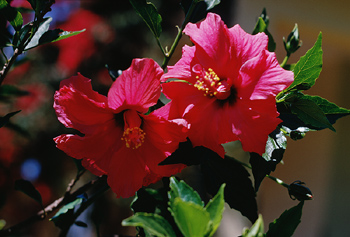How to Plant Hibiscus
Hibiscus is a striking and varied type of flower that many florists want in their garden. For this reason, learning how to plant hibiscus plants is something most gardeners want to learn, because hibiscus is an enjoyable addition to any garden. You can plant hibiscus flowers either indoors or outdoors, but the outdoor variety is what I suggest, since hibiscus attracts bees and butterflies, and therefore adds a lot of life to your garden.
Why Plant Hibiscus?
Hibiscus’s flowering parts add a great visual element to your plant display, while hibiscus has other advantages, as well. Hibiscus is used to make hibiscus tea, which can be much more enjoyable if made at home fresh. Usually, this homemade tea is of higher quality than store bought hibiscus tea bags, which tend to travel far and may not always be fresh.
Hibiscus is the key ingredient in another famous drink, sorrel, which is produced throughout the Caribbean. Also, the fibers of hibiscus plants are often used to make grass skirts in many cultures.
Getting Started With Hibiscus
There are several initial concerns regarding the planting hibiscus. Decide whether to plant from seeds or buy sprout plant samples. If you use sprouts, you don’t have to wait through the germination period to see your plants. You have more control and involvement with seeds.
Also, decide the place you’re going to plant your flowers. As I mentioned before, you can grow hibiscus indoors or outdoors, depending on your climate. Take into consideration the growing season in your area, along with the time of year you choose to grow your hibiscus.
When considering the climate, take into consideration rainfall, temperature and precipitation. You can control these factors more by growing your hibiscus inside, though this requires more care, attention and resources.
If you plant hibiscus indoors, purchase timed lights, a watering system and many plant holders and pots. You need a few basic elements to get started, regardless of whether you plant inside or outside.
- Fertile Soil
- Plant Holder/Pots
- Spade
- Watering Can
- Seeds/Sprout
- Fertilizer
Preparing the Soil

How to Plant Hibiscus
Learning how to plant hibiscus isn’t involved or demanding and the steps taken are roughly the same as others seeds you’ve planted. Decide whether to plant inside your home or outside in a garden.
Till the soil and remove any weeds or other organisms harmful to hibiscus, if you plant outdoors. Add fertilizer or some other alternative soil enrichment product such as manure or compost to the soil, after tilling. Dig a hole and plant your hibiscus.
Planting Hibiscus
If you use a seed, plant them 2-3 inches underground. If you have an existing plant sprout, you need something closer to 6-8 inches below the ground. Once you plant, cover the plant or seed with a mixture of soil and soil-enrichment products.
Water the mound that you covered.
Your plant should germinate and sprout into a mature, budding and flowering plant over the first couple of weeks. Maintenance of hibiscus isn’t demanding. Make sure the plant is receiving a full day’s worth of sunshine during the prime growing season and about 1 inch of water per week to survive on.
Be on the lookout for weeds or flower-eating pests, if you’re planting your hibiscus outside in your garden. Make sure your hibiscus is placed in a prime spot for sunlight, or that you have sufficient sun-replacement lights timed to provide the right amount of UV rays required for proper growth.
Harvesting your flowers is simple. Pick the flowers off the plant gently with your hands, after they have bloomed. Grow multiple hibiscus plants, so you can take a couple flowers from each plant, instead of all the flowers from one plant.
This keeps your existing plants looking healthy and attractive and won’t kill them by overharvesting their flowers. Now that you know how to plant hibiscus, your flower garden is going to be full of bright red, pink, purple or yellow colors – depending on your choice of hibiscus. My favorite is the good, old-fashioned white hibiscus, but that’s just my way.
